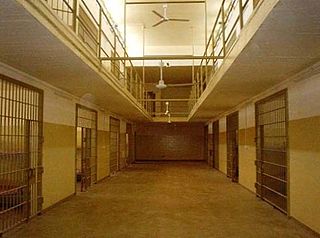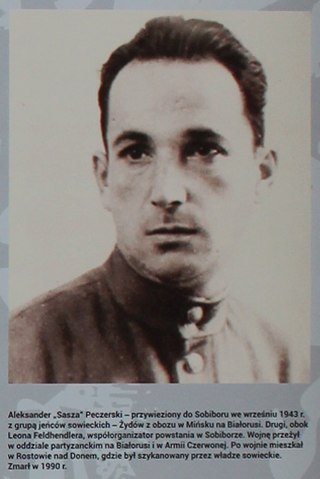
Auschwitz concentration camp was a complex of over 40 concentration and extermination camps operated by Nazi Germany in occupied Poland during World War II and the Holocaust. It consisted of Auschwitz I, the main camp (Stammlager) in Oświęcim; Auschwitz II-Birkenau, a concentration and extermination camp with gas chambers; Auschwitz III-Monowitz, a labour camp for the chemical conglomerate IG Farben; and dozens of subcamps. The camps became a major site of the Nazis' Final Solution to the Jewish question.

Sobibor was an extermination camp built and operated by Nazi Germany as part of Operation Reinhard. It was located in the forest near the village of Żłobek Duży in the General Government region of German-occupied Poland.

From 1933 to 1945, Nazi Germany operated more than a thousand concentration camps, including subcamps on its own territory and in parts of German-occupied Europe.

Abu Ghraib prison was a prison complex in Abu Ghraib, Iraq, located 32 kilometers (20 mi) west of Baghdad. Abu Ghraib prison was opened in the 1950s and served as a maximum-security prison. From the 1970s, the prison was used by Saddam Hussein to hold political prisoners and later the United States to hold Iraqi prisoners. It developed a reputation for torture and extrajudicial killing, and was closed in 2014.

Płaszów or Kraków-Płaszów was a Nazi concentration camp operated by the SS in Płaszów, a southern suburb of Kraków, in the General Governorate of German-occupied Poland. Most of the prisoners were Polish Jews who were targeted for destruction by Nazi Germany during the Holocaust. Many prisoners died because of executions, forced labor, and the poor conditions in the camp. The camp was evacuated in January 1945, before the Red Army's liberation of the area on 20 January.

Operation Harvest Festival was the murder of up to 43,000 Jews at the Majdanek, Poniatowa and Trawniki concentration camps by the SS, the Order Police battalions, and the Ukrainian Sonderdienst on 3–4 November 1943.

A prisoner-of-war camp is a site for the containment of enemy fighters captured as prisoners of war by a belligerent power in time of war.

Escape from Sobibor is a 1987 British television film which aired on ITV and CBS. It is the story of the mass escape from the Nazi extermination camp at Sobibor, the most successful uprising by Jewish prisoners of German extermination camps. The film was directed by Jack Gold and shot in Avala, Yugoslavia. The full 176-minute version shown in the UK on 10 May 1987 was pre-empted by a 143-minute version shown in the United States on 12 April 1987.

Fort Breendonk is a former military installation at Breendonk, near Mechelen, in Belgium which served as a Nazi prison camp (Auffanglager) during the German occupation of Belgium during World War II.

Stalag Luft III was a Luftwaffe-run prisoner-of-war (POW) camp during the Second World War, which held captured Western Allied air force personnel.

The Crveni Krst concentration camp, also known as the Niš concentration camp, located in Crveni Krst, Niš, was operated by the German Gestapo and used to hold captured Serbs, Jews and Romanis during the Second World War. Established in mid-1941, it was used to detain as many as 35,000 people during the war and was liberated by the Yugoslav Partisans in 1944. More than 10,000 people are thought to have been killed at the camp. After the war, a memorial to the victims of the camp was erected on Mount Bubanj, where many inmates were shot. A memorial museum was opened on the former campgrounds in 1967 and in 1979 the campgrounds were declared a Cultural Monument of Exceptional Importance and came under the protection of the Socialist Republic of Serbia.
During the Iraq War, many insurgents, al-Qaeda and militant fighters were captured and held at military bases in the region. On several occasions, there were instances of prisoner escapes.

Alexander "Sasha" Aronovich Pechersky, also known as Oleksandr Aronovych Pecherskyi, was a Jewish-Soviet officer. He is one of the organizers, and the leader, of the most successful uprising and mass-escape of Jews from a Nazi extermination camp during World War II, which occurred at the Sobibor extermination camp on 14 October 1943.

During World War II, Soviet prisoners of war (POWs) held by Nazi Germany and primarily in the custody of the German Army were starved and subjected to deadly conditions. Of nearly six million that were captured, around three million died during their imprisonment.

Camp Morton was a military training ground and a Union prisoner-of-war camp in Indianapolis, Indiana, during the American Civil War. It was named for Indiana governor Oliver Morton. Prior to the war, the site served as the fairgrounds for the Indiana State Fair. During the war, Camp Morton was initially used as a military training ground. The first Union troops arrived at the camp in April 1861. After the fall of Fort Donelson and the Battle of Shiloh, the site was converted into a prisoner-of-war camp. The first Confederate prisoners arrived at Camp Morton on February 22, 1862; its last prisoners were paroled on June 12, 1865. At the conclusion of the war, the property resumed its role as the fairgrounds for the Indiana State Fair. In 1891 the property was sold and developed into a residential neighborhood known as Morton Place, a part of the Herron-Morton Place Historic District.

Macikai POW and GULAG Camps is the complex of prisoner-of-war camp and forced labor camps located near the village og Macikai (Matzicken) in German-occupied Lithuania and later, the Lithuanian SSR. The camp was opened and operated by Nazi Germany (1939–1944), and later became a Soviet prisoner-of-war camp No. 184 (1945–1948), finally transforming into a Soviet GULAG forced-labour camp (1945–1955).

Erich Bauer, sometimes referred to as "Gasmeister", was a low-level commander in the Schutzstaffel (SS) of Nazi Germany and a Holocaust perpetrator. He participated in Action T4 program and later in Operation Reinhard, when he was a gas chamber operator at Sobibór extermination camp. In 1950 he was sentenced to death, later commuted to life imprisonment.

Dulag Luft were German Prisoner of War (POW) transit camps for captured airmen from any of the allied air forces during World War II. Their main purpose was to act as collection and interrogation centres for newly captured aircrew, before they were transferred in batches to the permanent camps.

Members of the German military were interned as prisoners of war in the United States during World War I and World War II. In all, 425,000 German prisoners lived in 700 camps throughout the United States during World War II.